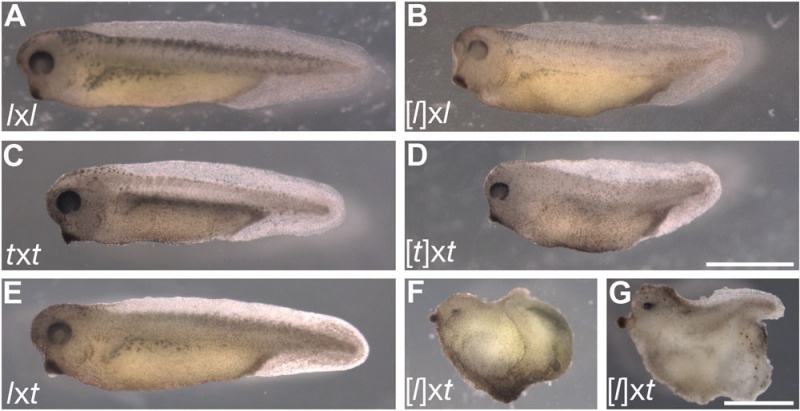File:Xenopus androgenetic haploids-hybrids-cybrids.jpg

Original file (1,000 × 514 pixels, file size: 85 KB, MIME type: image/jpeg)
Early development of Xenopus androgenetic haploids, hybrids, and cybrids
(A–D) Haploid development frequently gives rise to stunted swimming tadpoles in both X. laevis and X. tropicalis.
Typical stage 38 (A) lxl, (B) [l]xl (lx[l] were identical (unpublished data)), (C) txt, and (D) [t]xt embryos are shown. (E) Haploid X. laevis development is improved by the addition of a X. tropicalis sperm nucleus. A typical stage 38 lxt hybrid is shown. (F–G) [l]xt cybrids have a reduced developmental capacity compared to [l]xl or [t]xt and never form swimming tadpoles. Two of the most developmentally advanced [l]xt cybrid postneurulae after ~72 h at 23°C are shown.
Substantial posterior axis elongation such as in the individual shown in (G) is very rare and occurs in less than 1% of [l]xt cybrids. Scale bars in (A–B, E–G) and (C–D): 1 mm.
Reference
<pubmed>22131902</pubmed>| PLoS Biol.
Copyright: © 2011 Narbonne et al. This is an open-access article distributed under the terms of the Creative Commons Attribution License, which permits unrestricted use, distribution, and reproduction in any medium, provided the original author and source are credited.
Figure 1. Journal.pbio.1001197.g001.jpg doi:10.1371/journal.pbio.1001197.g001
File history
Click on a date/time to view the file as it appeared at that time.
| Date/Time | Thumbnail | Dimensions | User | Comment | |
|---|---|---|---|---|---|
| current | 16:51, 9 October 2012 |  | 1,000 × 514 (85 KB) | Z8600021 (talk | contribs) | ==Early development of Xenopus androgenetic haploids, hybrids, and cybrids== (A–D) Haploid development frequently gives rise to stunted swimming tadpoles in both X. laevis and X. tropicalis. Typical stage 38 (A) lxl, (B) [l]xl (lx[l] were identical (un |
You cannot overwrite this file.
File usage
The following page uses this file: